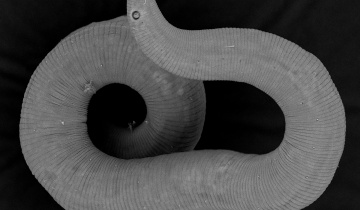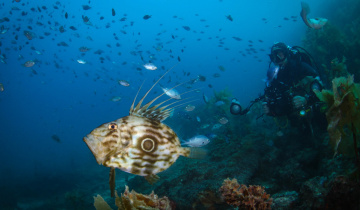This week’s critter is the colonial ascidian, or more commonly known as seasquirt, Leptoclinides marmoreus Brewin, 1956. This beautiful image of an anemone surrounded by the encrusting colony of seasquirts was taken in the Poor Knights Island by renowned underwater photographer Richard Robinson.
Richard won the 2014 Canon Media Awards “Press Photographer of the Year”. You can see more of his absolutely breath-taking images here, including more examples of sea squirts here.

A colony of Leptoclinides marmoreus Brewin, 1956 surrounds a sea anemone in the Poor Knights. Copyright: Richard Robinson © 2014, reproduced with permission.
Sea squirts are much more closely related to us than other invertebrate groups in the animal kingdom. In their mobile tadpole-like larval stage they have a dorsal nerve cord which places them in the subphylum Tunicata, part of the phylum Chordata to which we humans belong (Shenkar et al., 2015).
There are two types of seasquirt, solitary and colonial, and both filter feed by drawing seawater through an inhalant siphon into their sac-like body and collecting any yummy planktonic particles on a mucus net-like filter. The water, feces and gametes (sperm and eggs) are squirted out through their exhalent siphon. In a solitary species, there are just the in and out siphons, in a colonial beast there are many zooids and siphons, and you can see these in another close-up photo of L. marmoreus by Richard Robinson.

A close-up of the colourful zooids and siphons of the colonial seasquirt Leptoclinides marmoreus in the Poor Knights. Copyright: Richard Robinson © 2014, reproduced with permission.
Leptoclinides marmoreus Brewin, 1956 is an encrusting form of colonial ascidian, which covers rock surfaces with a 3mm thick mat giving a marbled appearance to the surface. It can be found in the northern waters of New Zealand, and is relatively common at diving depths north of Auckland around the Hen & Chicken Islands, Leigh, and Spirit’s Bay.
The Ascidiacea have almost 3000 described species worldwide. Here in New Zealand we have some spectacular and colourful ascidians, and you can download a NIWA Seasquirt ID guide for free to help you spot some next time you are going out for a dive or snorkel.





